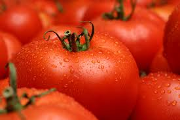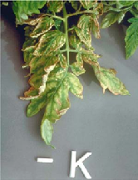Biomega Dilos K
Potassium in plants
Potassium is vital to many plant processes. A review of its role involves understanding the basic biochemical and physiological systems of plants. While K does not become a part of the chemical structure of plants, it plays many important regulatory roles in development. More specifically potassium helps in:
- Enzyme Activation
- Stomatal Activity (Water Use)
- Transport of Sugars
- Photosynthesis
- Starch Synthesis
How potassium works to increase crop yields
- Increases root growth and improves drought resistance
- Activates many enzyme systems
- Maintains turgor; reduces water loss and wilting
- Aids in photosynthesis and food formation
- Reduces respiration, preventing energy losses
- Enhances translocation of sugars and starch
- Produces grain rich in starch
- Increases protein content of plants
- Builds cellulose and reduces lodging
- Helps retard crop diseases

Potassium deficiency
Potassium deficiency, also known as potash deficiency, is a plant disorder that is most common on light, sandy soils, because potassium ions (K+) are highly soluble and will easily leach from soils without colloids. Potassium deficiency is also common in chalky or peaty soils with a low clay content. It is also found on heavy clays with a poor structure.

Potassium deficiency symptoms
Typical symptoms of potassium deficiency in plants include brown scorching and curling of leaf tips as well as chlorosis (yellowing) between leaf veins. Purple spots may also appear on the leaf undersides. Plant growth, root development, and seed and fruit development are usually reduced in potassium-deficient plants. Often, potassium deficiency symptoms first appear on older (lower) leaves because potassium is a mobile nutrient, meaning that a plant can allocate potassium to younger leaves when it is K deficient. Deficient plants may be more prone to frost damage and disease, and their symptoms can often be confused with wind scorch or drought. The deficiency is most common in several important fruit and vegetable crops.
Specific plant symptoms
Potatoes: Tuber size is much reduced and crop yield is low. The leaves of the plant appear dull and are often blue-green in color with internal chlorosis. Leaves will also develop small, dark brown spots on the undersides and a bronzed appearance on the upper surfaces.
Brassicas: Leaves are blue-green in color and may have a low degree of internal chlorosis. Scorching along the outside edges of leaves is common, and leaves are often tough in texture due to slow growth.
Tomatoes: The stems are woody and growth is slow. Leaves are blue-green in color, and the internal area often fades to a pale gray color. Leaves may also have a bronzed appearance and yellow and orange patches may develop on some of the leaflets. Fruits often ripen unevenly and sometimes have green patches near the stalks.
Apples: Leaves are scorched around the edges, and internal chlorosis is common. Apple fruits often have a slightly acidic or woody taste.
Biomega is offering Dilos K, a liquid product which contais 30% potassium & 10% aminoacids for faster absorption of the nutrients and stimulation of the plant.
